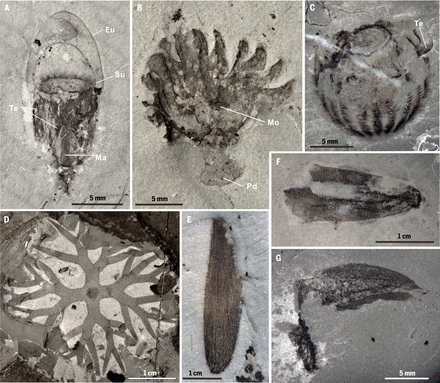The Qingjiang biota, a newly discovered fossil site in China, is a treasure trove for paleontologists studying the Cambrian explosion, when life on Earth suddenly and massively expanded in diversity about 500 million years ago.
More than 2,000 specimens were found at the 518 million-year-old site, and half of those specimens represent species of animals that scientists had never seen before.
The Qingjiang biota exhibits Burgess Shale-type preservation, signifying, that some of the soft-body fossils at the site are preserved as carbonaceous compressions. In other words, the original organic-carbon of the creature was preserved as a compression, creating a fossil that paleontologists can examine today. I have always found it astounding to imagine that the original organic-carbon of a creature can be examined half a billion years later.
At the Burgess Shale Geoscience Foundation, we are quite excited by the jellyfish (Cnidarians) and comb jellies (Ctenophores) that have been found at the Qingjiang site. Jellyfish are very much underrepresented at the Burgess Shale. This has led to a knowledge gap regarding Cambrian aged Cnidarians. Since, Cnidarians are thought to be some of the earliest animals that evolved on the planet their absence from Cambrian aged fossil sites was puzzling. The Qingjiang site is even more impressive because it has preserved both medusoid and polypoid forms of Cnidarians. These fossils present the potential to yield major insights into our understanding of early animal evolution.
At the Burgess Shale Geoscience Foundation, we anticipate that more papers will be published about the Qingjiang biota. We are expecting some very interesting discoveries in the next few years, and we intend to write about them, here, on our blog.
Click here to see the article

(A) Medusoid cnidarian, showing radially symmetrical body plan, exumbrellar/subumbrellar surfaces (Eu/Su), manubrium (Ma), and tentacles (Te). (B) Polypoid cnidarian, showing oral disc and mouth (Mo), tentacles, column, and pedal disc (Pd). (C) Ctenophore, showing that comb rows and oral-aboral body axis have a biradial symmetry resulting from sheathed tentacles. (D) Branched alga, showing quadripartite thallus. (E) Sponge Leptomitella sp. (F) New chordate. (G) Yunnanozoon sp.
Fu et Al.
Science 22 Mar 2019:
Vol. 363, Issue 6433, pp. 1338-1342
DOI: 10.1126/science.aau8800

